Get this easy tteokbokki recipe on the table in just 10 minutes! This spicy Korean rice cake stir fry features chewy tteok rice cakes in a flavour-packed tteokbokki sauce. It’s quick, easy and deliciously spicy.
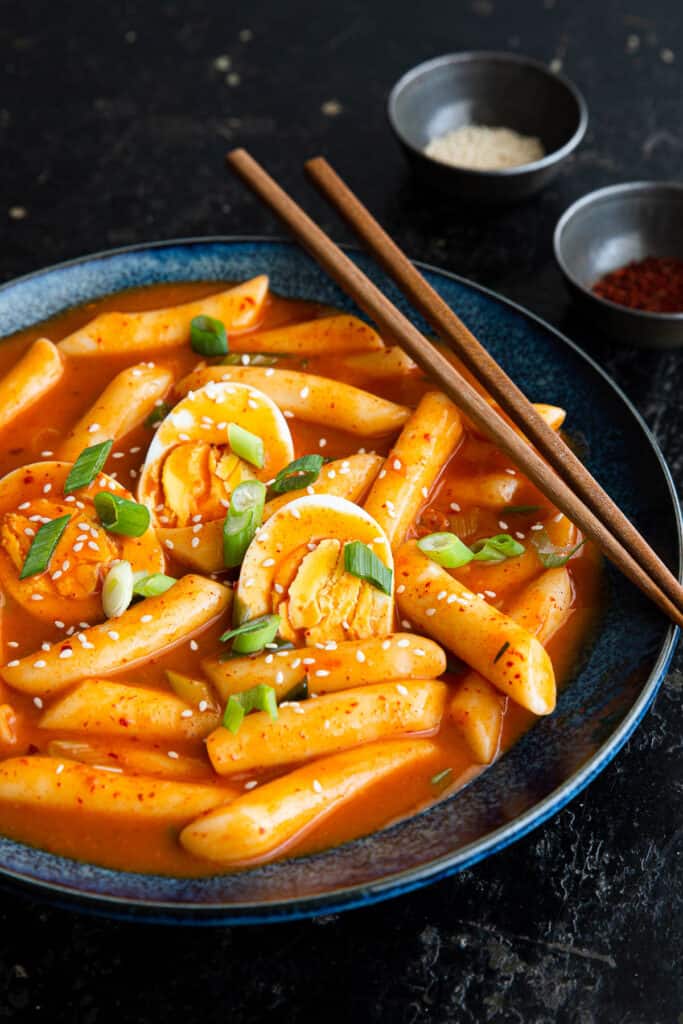
In This Post You’ll Learn
Why We Love This
If you love Korean street food, you’ll love this amazing homemade tteokbokki recipe! It’s cheap to make, flavourful and deliciously filling, perfect as a spicy meal for lunch, dinner or as a quick and easy snack.
The simple stock base features powdered dashi along with classic Korean ingredients like Korean chili flakes and gochujang paste.
Keep it simple with just the essential stir fried rice cakes, or adapt the recipe with extra ingredients like Korean fish cakes (eomuk) or even leftover veggies from the fridge!
Related: Gungjung Tteokbokki (Non Spicy Tteokbokki) / Tteokkochi Skewers
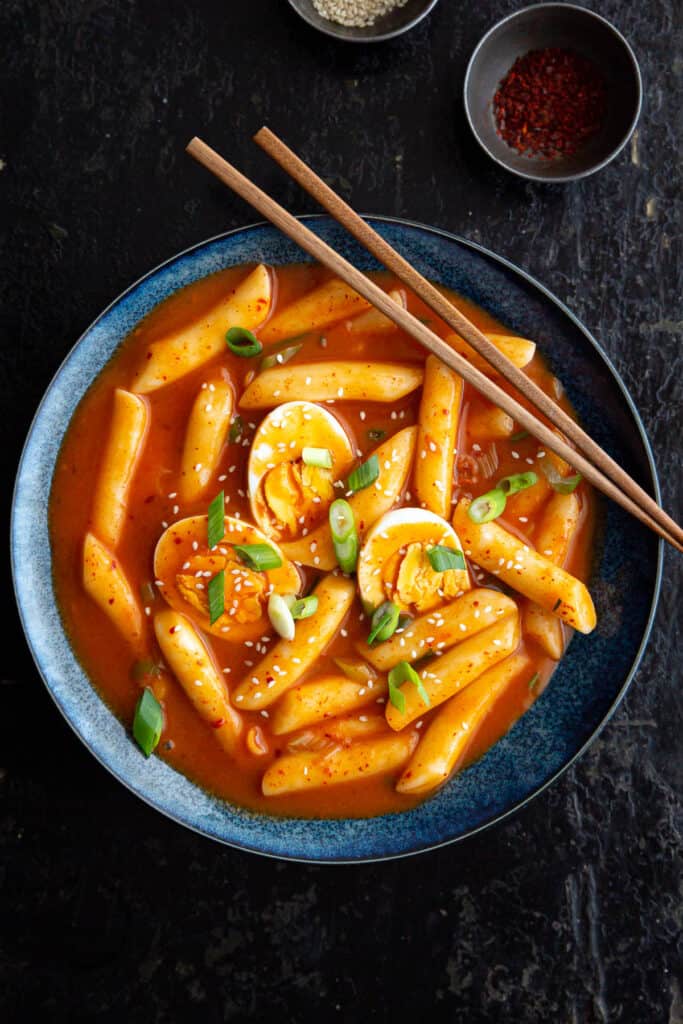
What is Tteokbokki?
Tteokbokki (떡볶이, sometimes romanised as ddukbokki or topokki) is one of the most popular Korean street food recipes!
Soft and chewy rice cakes are stir fried in a thick tteokbokki sauce made with seaweed or fish stock, gochujang paste and gochugaru chilli flakes.
You’ll find it at bunsikjip snack bars or pojangmacha street food stalls, where street vendors work behind massive hot plates to stir fry the rice cakes in bright red tteokbokki sauce. Some will serve it with eomuk fish cakes individually or threaded onto skewers, others with seafood or boiled eggs with green onions as a garnish.
We first came across tteokbokki rice cakes while roaming the streets of Nampo-dong in Busan, South Korea. This place is MADE for food lovers. You can easily spend hours here just wandering along, eating tteokbokki and finishing off with sweet hotteok pancakes for dessert!
What You’ll Need
- Garaetteok (가래떡 / Korean Rice Cakes) – These are the chewy cylindrical rice cakes you’ll find in other Korean dishes like dakgalbi. We usually buy them frozen, but they can also be prepared as dried, shelf stable rice cakes. The best place to look for them is the fridge or freezer section of Asian or Korean grocery stores.
- Gochujang / Korean Hot Pepper Paste – One of the key flavours in Korean cuisine. While it is spicy, it has more of a well-rounded, sweet tomato flavour rather than just pure chilli heat. (Note: You can buy an extra hot version if you want!). It’s available at Asian groceries, well stocked supermarkets in the international aisle, or online. If you can’t source it, you can make a paste out of regular red chilli flakes mixed with sugar and a dash of soy. Use 1 tablespoon of chilli flakes for every tablespoon of gochujang required.
- Gochugaru / Korean Red Chilli Flakes – It may also be labelled as Korean hot pepper powder. Most brands have clear packaging so you can see the product inside (which is important). Ideally you should buy the flakes, NOT the powdered version. Look for it at Asian supermarkets or online. Sub with half the listed amount of cayenne pepper or regular chilli powder.
- Dashi Stock Powder – Known as yuksu in Korean or dashi in Japanese. The Japanese version tends to be more widely available and there are two main styles you can choose from: kombu dashi (vegan friendly, less intense flavour made from dried kelp) or katsuo dashi (more intense umami flavour, made with dried anchovies). Sub with vegetable or chicken stock if you prefer.
- Other Ingredients – You’ll need soy sauce, sugar and sesame oil for the sauce. Optional additions include Korean fish cakes, boiled eggs and spring onions / green onions to serve.
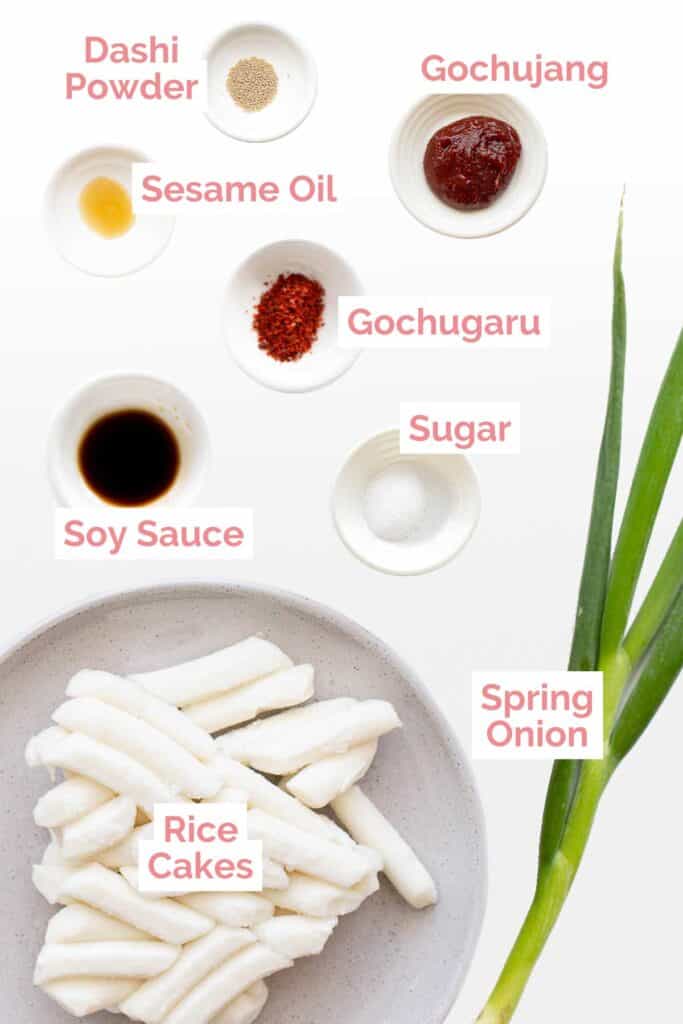
How to Make Tteokbokki
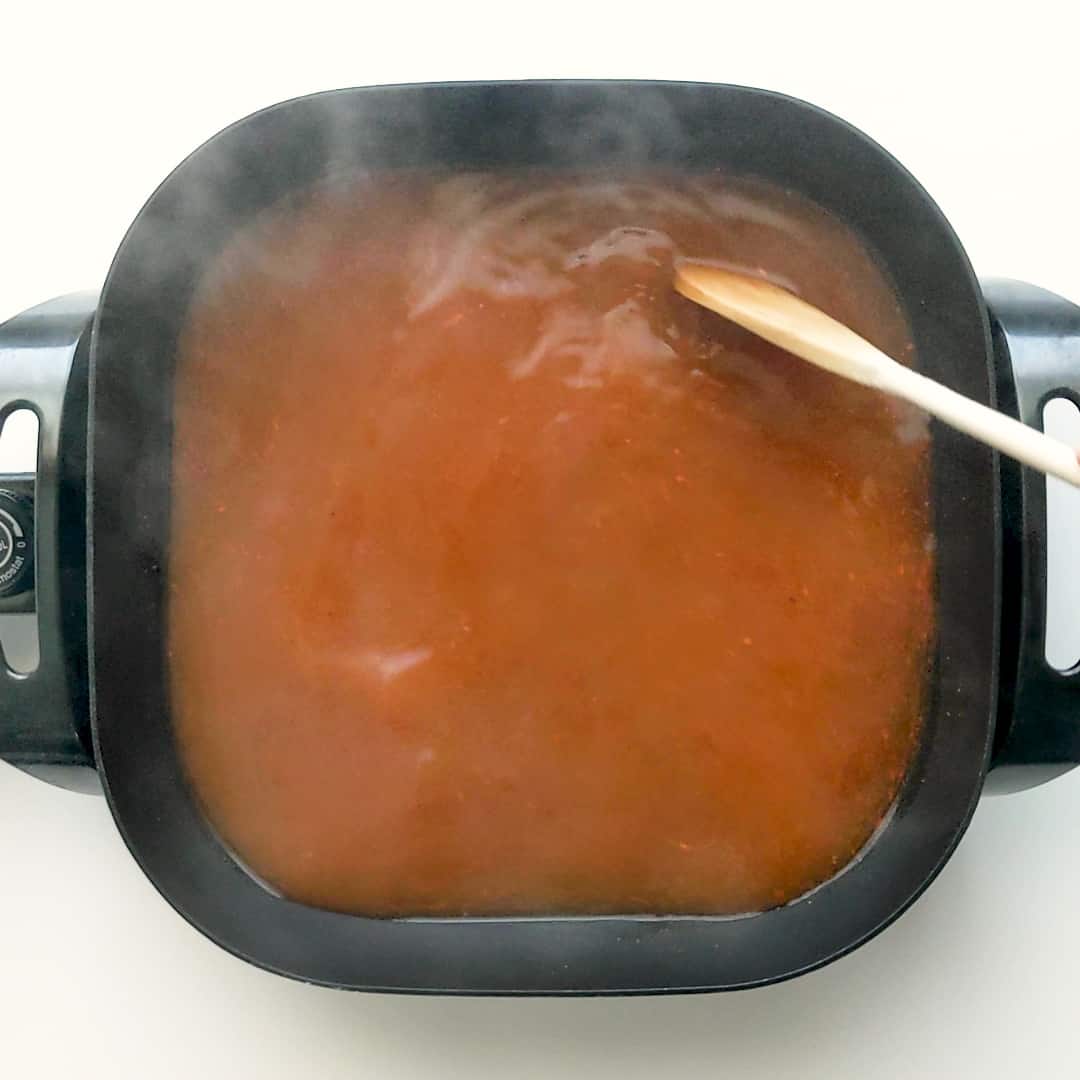
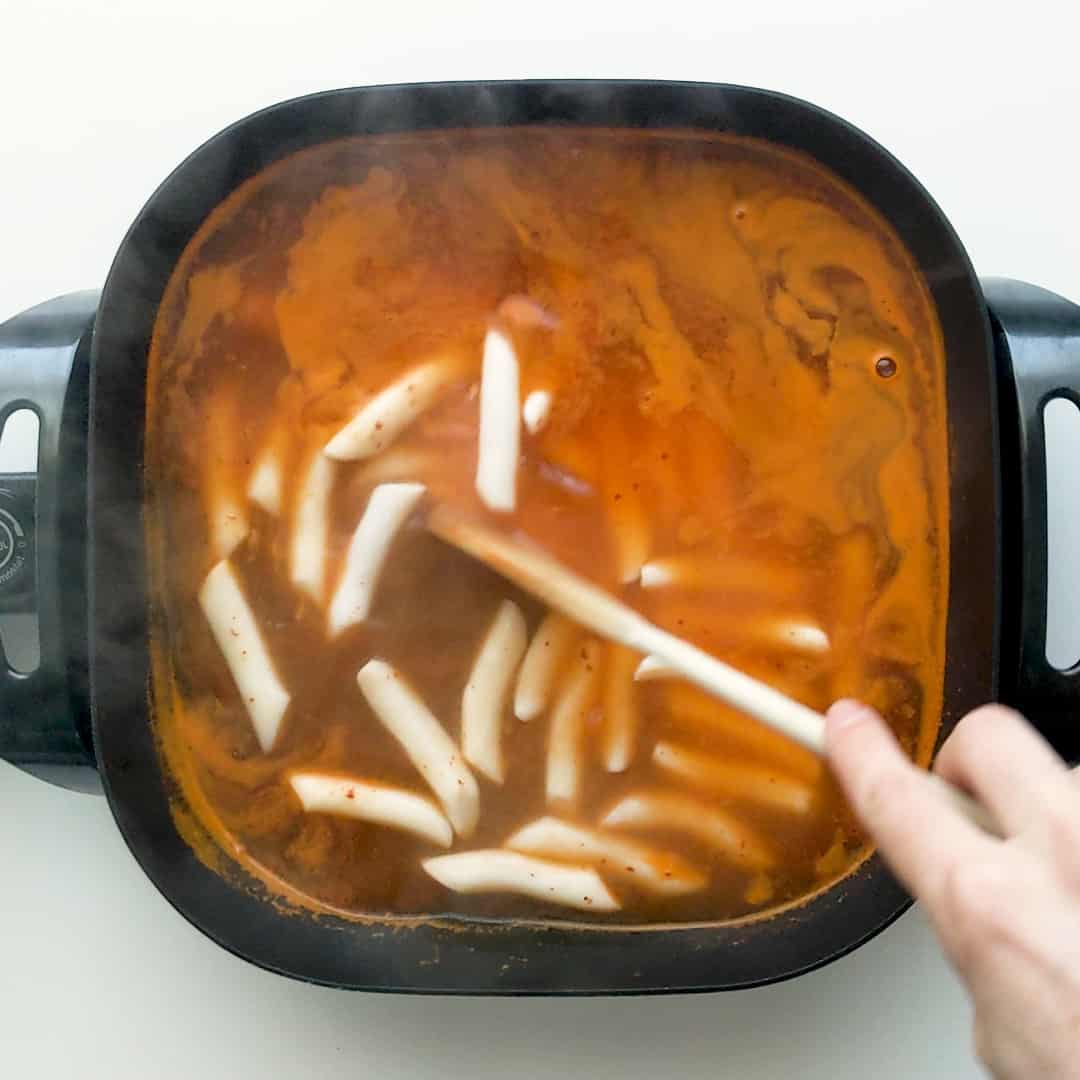
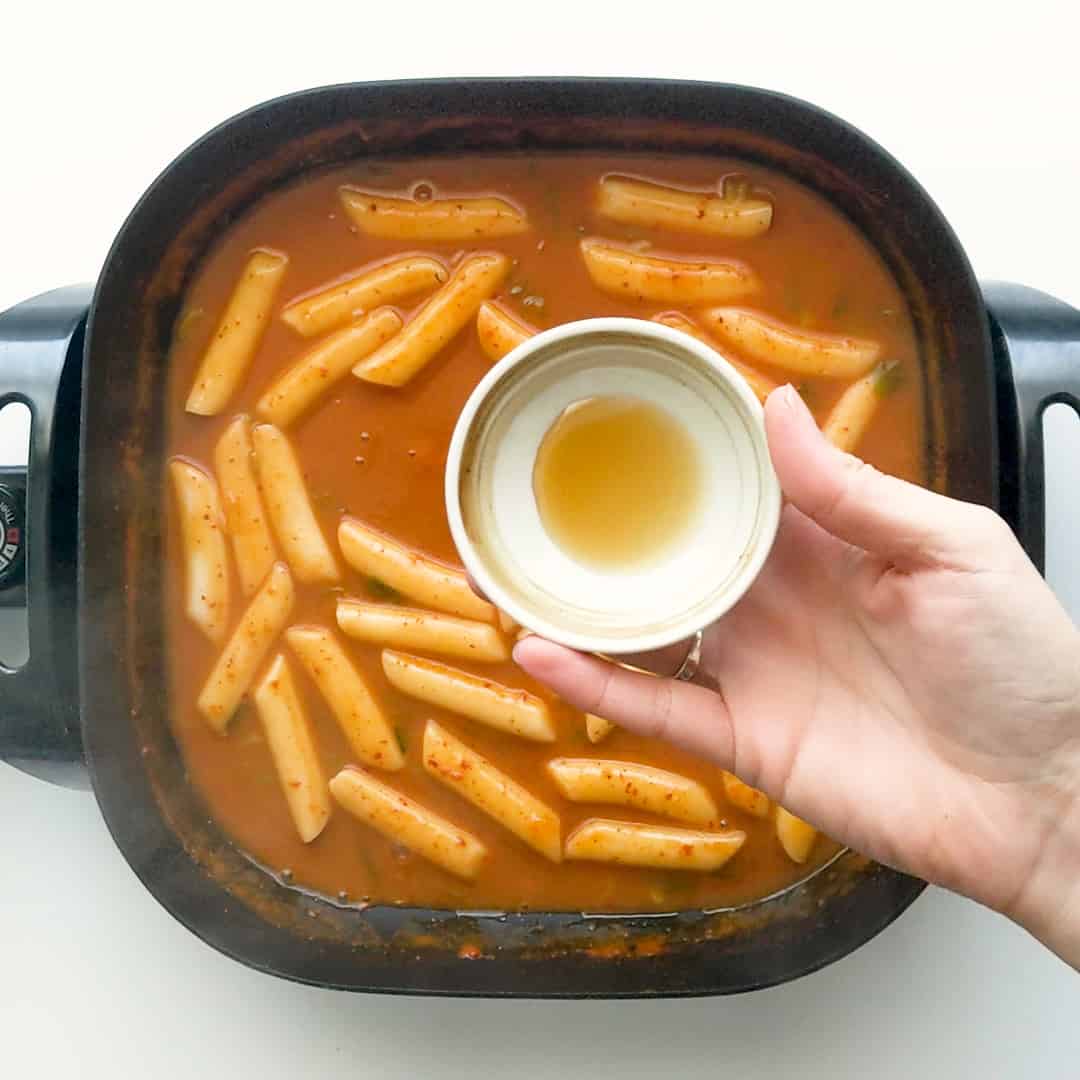
First, gather your ingredients: See recipe card below for measurements.
- Pour water and dashi powder into a large wok, frying pan or skillet and bring to the boil. Add the gochujang, gochugaru chilli flakes, sugar and soy sauce and stir until evenly mixed through the stock.
- Add the tteok rice cakes and spring onions / green onions and bring back to the boil, then simmer for around 10 minutes, stirring frequently, until the rice cakes have softened and the sauce has thickened. Tip: If the rice cakes aren’t soft enough, add a little more water and continue to cook until soft.
- Just before serving, stir in the sesame oil. Transfer to serving plates and garnish with more spring onion / green onion.
Wandercook’s Tips
- Frozen Rice Cakes – These are often stuck together in the package. You can tap the bag against your kitchen bench (or the floor if they’re being extra stubborn!) to loosen them up and make it easier to portion out how much you need. You can also soak them in boiling water for a few minutes before cooking to help them defrost and speed up the cooking time.
- Dried Rice Cakes – Soak in boiling water for around 10-20 minutes before cooking to soften them up. If you have more time, soak them in cold water for around 3 hours or overnight if you prefer.
- Storage – Tteokbokki will last a few days in the fridge if stored in an airtight container. We don’t recommend freezing as the texture of the rice cakes won’t be the same.
FAQs
Tteokbokki is traditionally a very spicy dish! We’ve toned our recipe down slightly, but if you need to reduce the heat even further you can cut back on (or omit) the gochugaru chilli flakes or reduce the amount of gochujang paste you use.
The trick is to cook the sauce on low to medium heat and be patient. This should usually be enough, but if it’s still not thickening up, try adding a slurry of 1 tsp cornflour / cornstarch mixed in 2 tsp cold water.
While you can reheat it in a microwave, it’s better to reheat tteokbokki slowly in a pan or wok on the stove. Add a little extra water or stock and stir gently over low heat until warmed through. This will help stop the spicy rice cakes becoming mushy.
Tteokbokki is usually eaten on its own, but to make it go further you could serve it with some banchan side dishes like Korean seasoned spinach, bean sprout salad, pickled onions or pickled garlic.
Variations
- Protein – Try adding chicken, thinly sliced pork, seafood (shrimp, squid, fish cakes), or spam sausages similar to Korean army stew.
- Veggies – Add chopped cabbage, bok choy, broccolini, red bell pepper / capsicum, your favourite mushrooms or kimchi.
- Rabokki – Add ramen noodles or instant noodles (cooked first so they don’t soak up too much of the sauce).
- Cheese Tteokbokki – Sprinkle grated cheddar or pizza cheese over the top, or layer with cheese slices. Cover and steam for a minute or two until the cheese has melted.
- Garnish – Sprinkle the top with white sesame seeds, toasted sesame seeds (for extra nuttiness) or gomashio.
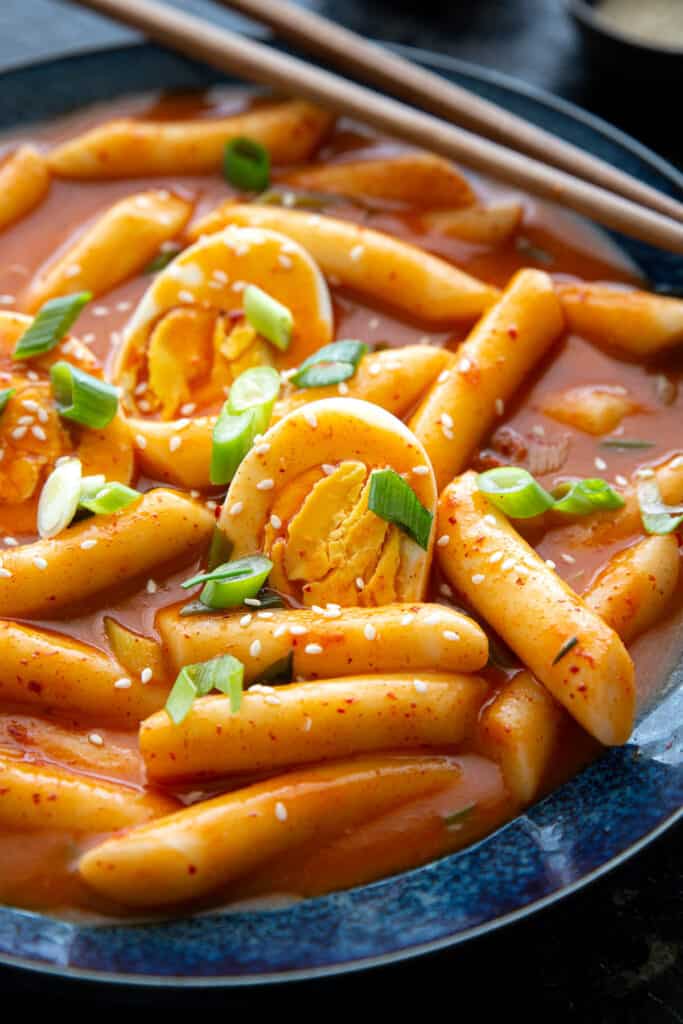
Try these amazing recipes next:
- Bulgogi – Korean BBQ Beef with Shiitake Mushroom – Easy Korean BBQ at home!
- Spicy Korean BBQ Chicken Bulgogi – Dak Bulgogi – Sweet, savoury and spicy chicken.
- Korean Bean Sprout Soup – Kongnamul Guk – A deliciously light and soothing soup stock.
- 10 Minute Creamy Gochujang Pasta – Super quick and satisfying with amazing Korean flavours.
- Easy Chicken Bibimbap – Korean Rice Bowl – The best Korean flavours in a deliciously easy rice bowl.
★ Did you make this recipe? Please leave a comment and a star rating below!
Equipment
Ingredients
- 750 g water
- 1 ½ tsp dashi powder stock powder
- 2 tbsp Korean hot pepper paste / gochujang Korean chilli paste
- 1 tsp Korean hot pepper flakes / gochugaru
- 1 tsp sugar
- 1 tsp soy sauce
- 150 g Korean rice cakes (tteok) round or flat, soaked overnight or prepared as below
- 1 spring onion / green onion some reserved as garnish
- 1 tsp sesame oil
Instructions
- Pour water and dashi powder into a large wok, frying pan or skillet and bring to the boil. Add the gochujang, gochugaru chilli flakes, sugar and soy sauce and stir until evenly mixed through the stock.750 g water, 1 ½ tsp dashi powder, 2 tbsp Korean hot pepper paste / gochujang, 1 tsp Korean hot pepper flakes / gochugaru, 1 tsp sugar, 1 tsp soy sauce
- Add the tteok rice cakes and spring onions / green onions and bring back to the boil, then simmer for around 10 minutes, stirring frequently, until the rice cakes have softened and the sauce has thickened. Tip: If the rice cakes aren’t soft enough, add a little more water and continue to cook until soft.150 g Korean rice cakes (tteok), 1 spring onion / green onion
- Just before serving, stir in the sesame oil. Transfer to serving plates and garnish with more spring onion / green onion.1 tsp sesame oil, 1 spring onion / green onion
Video
Recipe Notes
- Garaetteok (가래떡 / Korean Rice Cakes) – These are the chewy cylindrical rice cakes you’ll find in other Korean dishes like dakgalbi. We usually buy them frozen from our local Asian supermarket. The best place to look for them is the fridge or freezer section of Korean convenience stores or Asian groceries, but you can also find them dried.
- Frozen Rice Cakes – These are often stuck together in the package. You can tap the bag against your kitchen bench (or the floor if they’re being extra stubborn!) to loosen them up and make it easier to portion out how much you need. You can also soak them in boiling water for a few minutes before cooking to help them defrost and speed up the cooking time.
- Dried Rice Cakes – Soak in boiling water for around 10-20 minutes before cooking to soften them up. If you have more time, soak them in cold water for around 3 hours or overnight if you prefer.
- Gochujang / Korean Hot Pepper Paste – One of the key flavours in Korean cuisine. While it is spicy, it has more of a well-rounded, sweet tomato flavour rather than just pure chilli heat. (Note: You can buy an extra hot version if you want!). It’s available at Asian groceries, well stocked supermarkets in the international aisle, or online. If you can’t source it, you can make a paste out of regular red chilli flakes mixed with sugar and a dash of soy. Use 1 tablespoon of chilli flakes for every tablespoon of gochujang required.
- Gochugaru / Korean Red Chilli Flakes – It may also be labelled as Korean hot pepper powder. Most brands have clear packaging so you can see the product inside (which is important). Ideally you should buy the flakes, NOT the powdered version. Look for it at Asian supermarkets or online. Sub with half the listed amount of cayenne pepper or regular chilli powder.
- Dashi Stock Powder – Known as yuksu in Korean or dashi in Japanese. The Japanese version tends to be more widely available and there are two main styles you can choose from: kombu dashi (vegan friendly, less intense flavour made from seaweed) or katsuo dashi (more intense umami flavour, made with anchovy). Sub with vegetable or chicken stock if you prefer.
- Other Ingredients – You’ll need soy sauce, raw sugar and sesame oil for the sauce. Optional additions include Korean fish cakes, boiled eggs and spring onions / green onions to serve.
- Storage – Tteokbokki will last a few days in the fridge if stored in an airtight container. We don’t recommend freezing as the texture of the rice cakes won’t be the same.
- Protein – Try adding chicken, thinly sliced pork, seafood (shrimp, squid, fish cakes), or spam sausages similar to Korean army stew.
- Veggies – Add chopped cabbage, bok choy, broccolini, red bell pepper / capsicum, your favourite mushrooms or kimchi.
- Rabokki – Add ramen noodles or instant noodles (cooked first so they don’t soak up too much of the sauce).
- Cheese Tteokbokki – Sprinkle grated cheddar or pizza cheese over the top, or layer with cheese slices. Cover and steam for a minute or two until the cheese has melted.
Nutrition






28 Comments
Nick
07/02/2022 at 12:38 amThe recipe calls for rice cakes and the Raman noodles. Is this an either or choice or are you recommending both?
Wandercooks
07/02/2022 at 11:51 amHi Nick, this recipe is for rice cakes only. 🙂 The ramen mentioned in the notes section is a variation which you can add as well if you want to, but that’s optional and totally up to you.
Nick
07/02/2022 at 11:49 pmWow… I made this and was it delicious. I did cut up a 1/2 lb. of chicken thighs and marinated them in the gochujang sauce and the sautéed them. I also read a replacement for the Korean red pepper would be Chipotle chilli powder so I used that. Them I followed the rest of the directions. Mmmmm!
One other point… I couldn’t find the unfrozen rice cakes so I placed the cakes in a bowl and let them come up to room temperature and they cooked up fine.
I have everything I need to make this again. Next time I’m going to use shrimp.
Wandercooks
09/02/2022 at 11:31 amOh nice work beefing the dish up with those ingredients. That would be so good with the marinated chicken! Also, we’ve thrown in our frozen rice cakes plenty of times without thawing them, and it’s turned out fine. It will just add a few minutes to cooking while everything heats back up. 🙂
Anna
05/04/2021 at 1:57 amMade the rice cakes myself and rice flour since I couldn’t get that where I live. The cakes were a bit soft but that’s because they were home made. Super easy and yummy recipe!!
Wandercooks
05/04/2021 at 12:23 pmAmazing Anna – nice work making your own rice cakes, how awesome! We might have to try making them ourselves too. Glad you enjoyed the recipe. 🙂
Milica Vladova
22/05/2020 at 10:36 amOh, I need to make this recipe. I hope I can find these Korean rice cakes in my country.
Wandercooks
22/05/2020 at 10:36 amFingers crossed you can – they are delish! If not, you could always try substituting with regular rice noodles. The texture will of course be different, but you can still enjoy all that delicious flavour. Hope you enjoy!
Tatiana
22/05/2020 at 10:36 amThank you for the wonderful receipe and the beautiful photography! Awesome recipe, I’ll sure try making it during this week! Thanks for sharing it!
Wandercooks
22/05/2020 at 10:36 amOoh yay can’t wait to hear what you think! 🙂
Farah
22/05/2020 at 10:36 amNever heard of this before and I feel I was missing out on so much! These sound addictive!
Wandercooks
22/05/2020 at 10:36 amLove making tasty new discoveries, there’s always something new to try!
Jo Allison
22/05/2020 at 10:36 amI love discovering new dishes so thanks for sharing this delicious Korean recipe! The flavours here sound fantastic and as I’ve never cooked with rice cakes I’m really keen to try it!
Wandercooks
22/05/2020 at 10:36 amOh fantastic Jo, hope you enjoy!
Mikayla
22/05/2020 at 10:36 amI love eating food like this but always get nervous making it myself, but this recipe makes me feel like I can! I love spicy korean food so this is going to be a favorite for sure!
Wandercooks
22/05/2020 at 10:36 amI know what you mean Mikalya! This one is a goody because the ingredients are so simple and quick to pull together. Glad we could help, we’d love to hear how you go with this one! 🙂
Emma @ Supper in the Suburbs
22/05/2020 at 10:36 amI’m so not confident when it comes to Korean food but looks like you’ve got it sussed! Great recipe!
Wandercooks
22/05/2020 at 10:36 amGood luck Emma – hope you enjoy your new flavour adventures.
Jayasri
22/05/2020 at 10:36 amSomething new I have learnt today, very interesting recipe bookmarked and love to try it out. Lovely clicks
Wandercooks
22/05/2020 at 10:36 amThanks Jayasri, hope you enjoy.
Luci
22/05/2020 at 10:36 amSpice is totally the best thing for tastebuds 😉 I’ve just added Korean rice cakes, katsuo dashi stock powder and gochujang to my “if I see them” shopping list, because we don’t have a store nearby! Saved the recipe and ready to go as soon as I do stumble across some though!
Wandercooks
22/05/2020 at 10:36 amGreat, fingers crossed you can get your hands on some of those tasty ingredients – you won’t regret it. P.S. Totally agree – nothing like a spicy meal to awaken the senses hahah. 😛
Mica @ Let's Taco Bout It Blog
22/05/2020 at 10:36 amTry saying Tteokbokki ten times fast. :p I would love to make this! I’ve never made a recipe with rice cakes before so I’m really excited to give this recipe a shot! What sides would you recommend I try with this?
Wandercooks
22/05/2020 at 10:36 amHaha we did – the good news is it’s MUCH easier to eat Tteokbokki it is to say. 😛 Being a popular street food snack it’s not often served with sides, but that said you could definitely make a feast out of it with a side of Korean Doenjang Guk (aka Miso Soup) and crunchy spicy Korean pickles. If you still haven’t had enough chilli, then don’t forget to have some Kimchi too!
Dahn @savor the Best
22/05/2020 at 10:36 amOh my goodness this looks awesome, you are so right I need this and I am going to have to make it. There is an Asian supermarket near me, I definitely want to try it with the rice cakes. Yum
Wandercooks
22/05/2020 at 10:36 amExcellent news, hope you enjoy wandering those aisles as much as we do! 😉
Cristie | Little Big H
22/05/2020 at 10:36 amThis so appeals to me, I love all of these flavours and the rice cakes have me intrigued. I’ve never cooked with them before! Adding this to my list of things to make asap…
Wandercooks
22/05/2020 at 10:36 amPlease do! But be warned, those chewy rice cakes are totally addictive. 😉